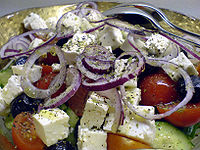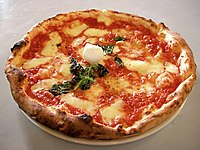User:The Ogre/soapbox
| This is a Wikipedia user page. This is not an encyclopedia article or the talk page for an encyclopedia article. If you find this page on any site other than Wikipedia, you are viewing a mirror site. Be aware that the page may be outdated and that the user in whose space this page is located may have no personal affiliation with any site other than Wikipedia. The original page is located at https://en.wikipedia.org/wiki/User:The_Ogre/soapbox. |
European cuisine, or alternatively Western cuisine, is a generalized term collectively referring to the cuisines of Europe and other Western countries. European cuisine or Western cuisine includes that of Europe including (depending on the definition) that of Russia, as well as non-indigenous cuisines of North America, Australasia, Oceania, and Latin America, which derive substantial influence from European settlers in those regions. The term is used by East Asians to contrast with Asian styles of cooking.[1] (This is analogous to Westerners referring collectively to the cuisines of East Asian countries as Asian cuisine.) When used by Westerners, the term may sometimes refer more specifically to cuisine in Europe or continental; in this context, a synonym is Continental cuisine, especially in British English.
The cuisines of Western countries are diverse by themselves, although there are common characteristics that distinguishes Western cooking from cuisines of Asian countries[2] and others. Compared with traditional cooking of Asian countries, for example, meat is more prominent and substantial in serving-size.[3] Steak in particular is a common dish across the West. Similarly to some Asian cuisines, Western cuisines also put substantial emphasis on sauces as condiments, seasonings, or accompaniments (in part due to the difficulty of seasonings penetrating the often larger pieces of meat used in Western cooking). Many dairy products are utilized in the cooking process, except in nouvelle cuisine.[4] Wheat-flour bread has long been the most common sources of starch in this cuisine, along with pasta, dumplings and pastries, although the potato has become a major starch plant in the diet of Europeans and their diaspora since the European colonization of the Americas. Maize is much less common in most European diets than it is in the Americas; however corn meal, or polenta, is a major part of the cuisine of Italy and the Balkans.
Eastern European cuisines
 Armenian cuisine
Armenian cuisine Azerbaijani cuisine
Azerbaijani cuisine Belarusian cuisine
Belarusian cuisine Bulgarian cuisine
Bulgarian cuisine Czech cuisine
Czech cuisine Georgian cuisine
Georgian cuisine Hungarian cuisine
Hungarian cuisine Moldovan cuisine
Moldovan cuisine Polish cuisine
Polish cuisine Romanian cuisine
Romanian cuisine Russian cuisine
Russian cuisine Slovak cuisine
Slovak cuisine Slovenian cuisine
Slovenian cuisine Tatar cuisine
Tatar cuisine Ukrainian cuisine
Ukrainian cuisine
Northern European cuisines
 British cuisine
British cuisine
 Danish cuisine
Danish cuisine Estonian cuisine
Estonian cuisine Finnish cuisine
Finnish cuisine Icelandic cuisine
Icelandic cuisine Irish cuisine
Irish cuisine Lappish cuisine
Lappish cuisine Latvian cuisine
Latvian cuisine Lithuanian cuisine
Lithuanian cuisine Norwegian cuisine
Norwegian cuisine Swedish cuisine
Swedish cuisine
Southern European cuisines
 Albanian cuisine
Albanian cuisine Bosnian cuisine
Bosnian cuisine Croatian cuisine
Croatian cuisine Cypriot cuisine
Cypriot cuisine Gibraltarian cuisine
Gibraltarian cuisine Greek cuisine
Greek cuisine
 Italian cuisine
Italian cuisine
 Macedonian cuisine
Macedonian cuisine Maltese cuisine
Maltese cuisine Montenegrin cuisine
Montenegrin cuisine Portuguese cuisine
Portuguese cuisine Serbian cuisine
Serbian cuisine Slovenian cuisine
Slovenian cuisine Spanish cuisine
Spanish cuisine
 Turkish cuisine
Turkish cuisine
Western European cuisines
 Austrian cuisine
Austrian cuisine Belgian cuisine
Belgian cuisine Dutch cuisine
Dutch cuisine French cuisine
French cuisine
 German cuisine
German cuisine Luxembourgian cuisine
Luxembourgian cuisine Swiss cuisine
Swiss cuisine
See also
References
- ^ Leung Man-tao (12 February 2007), "Eating and Cultural Stereotypes", Eat and Travel Weekly, no. 312, p. 76. Hong Kong
- ^ Kwan Shuk-yan (1988). Selected Occidental Cookeries and Delicacies, p. 23. Hong Kong: Food Paradise Pub. Co.
- ^ Lin Ch'ing (1977). First Steps to European Cooking, p. 5. Hong Kong: Wan Li Pub. Co.
- ^ Kwan Shuk-yan, pg 26










































